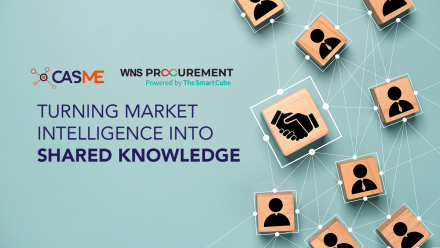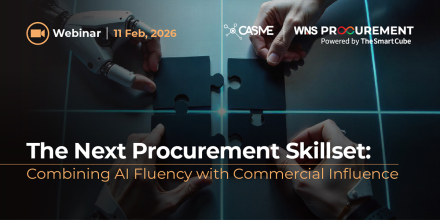
Indirect Procurement is a major cost for many companies, demanding a focus on the trends and risks expected. Organisations are confronted with inflation, politics, and labour issues, while emerging technologies offer efficiency gains. Adding value in this unstable landscape involves navigating numerous obstacles and seizing potential growth opportunities.
In the recent webinar, ‘Indirect Procurement in 2024: Adapting to Changing Dynamics and Maximising Value’, hosted by CASME and WNS Procurement (powered by The Smart Cube), more than 140 procurement professionals heard from a panel of industry experts who examined the key issues and future growth possibilities for the function.
Our expert panel:
Justin Virden, Executive Director and Global Head of Indirect Procurement at Amgen
Aditya Jain, Director, Global Procurement at VISA
Greg Anderson, North American Practice Leader at WNS Procurement
Graham Crawshaw, Procurement Content Director at CASME
Watch the full webinar on demand, and enjoy reading the highlights, top tips and benchmarking poll results below.
Dealing with Inflation
After reaching a peak, the rate of inflation has slowed in many countries. However, as the inflationary period continues in 2024, understanding cost drivers and supplier economics remains the main challenge for Indirect Procurement. This was confirmed by the first benchmarking poll, where 28% of the live audience identified inflation and its effect on contracts and suppliers as the most impactful issue for Procurement in the next 12 months.
Live Poll: Which area do you believe will have the most significant impact on Indirect Procurement for the second half of 2024 and first half of 2025?
Aditya Jain, Director, Global Procurement at VISA, highlighted that despite ongoing external financial pressures, CFOs are increasingly seeking additional cost optimisation to increase business investment and growth. This sentiment was echoed by 20% of the audience, who identified cost optimisation strategies as their main priority.
Justin Virden, Executive Director and Global Head of Indirect Procurement at Amgen, agreed, emphasising that the focus on financial management will increasingly target indirect spend categories, which often involve discretionary costs. He noted that inflation poses a significant challenge to achieving cost optimisation, while advancements in GenAI technology offer potential solutions by leveraging automation to offset inflationary pressures. A quarter (25%) of the audience recognised technology advancements and automation as having the biggest future impact on Indirect Procurement.
Knowledge is Power
Since the onset of the pandemic in 2020, Justin explained that Amgen has developed robust capabilities to identify and measure inflation’s impact on indirect categories and specific suppliers. This capability allows them to better understand the effects of inflation on the supply market and develop proactive mitigation plans to unlock value despite inflationary pressures.
Justin also emphasised the importance of becoming a ‘customer/client of choice’ to develop collaborative partnerships with suppliers. Such partnerships are necessary for overcoming challenges such as service erosion and labour/talent shortages – both of which are linked to inflation. Strategic supplier relationships, especially in categories with multiple suppliers and high competition, can lead to innovative approaches to mitigate inflation’s impact on the business.
As an international payment card services provider, VISA monitors consumer spending closely. Aditya noted that inflation has not necessarily affected overall consumer expenditure but has aligned closely with market volatility during uncertain times. He stressed the importance of gaining insights and making swift decisions during such volatile periods.
Modelling Costs
Greg Anderson, North American Practice Leader at WNS Procurement added to this by recommending Procurement conduct cost modelling exercises to understand the labour and wage components of products and services. This approach ensures that product/service specifications deliver the desired results while maintain cost control.
According to Graham Crawshaw, Procurement Content Director at CASME, members from the global procurement community are increasingly issuing RFx documents to assess supplier offerings and pricing in the marketplace. He emphasised the importance of focusing on should-cost and total cost of ownership in Indirect Procurement strategies.
Playing the Monopoly Game
Aditya highlighted the importance of establishing Procurement as the source of knowledge for stakeholders regarding the long-term economic trends and volatility, particularly in monopolistic markets. He emphasised the importance of having predictive capabilities in category management to make informed decisions about when and how much to procure.
Justin underscored the significance of deepening supplier relationships beyond transactional levels to effectively mitigate inflation. By understanding the supplier's cost dynamics and aligning business practices, opportunities to overcome inflationary challenges can be uncovered. For instance, Procurement should consider the following:
- How do our product/service specifications impact the supplier’s costs?
- How do our ways of working with the supplier affect their costs?
Ultimately, addressing inflationary pressures in Indirect Procurement requires a multifaceted approach that includes leveraging technology, strategic supplier partnerships, and deep understanding of cost dynamics across categories and suppliers.
Reflections on The Talent Pool
During the last two decades, organisations have invested in their sourcing functions to achieve significant business impact. Yet gaining access to suitable and sustainable talent resources depends on factors such as business sector, brand reputation, talent affordability, and geographic location.
For some organisations, Justin explained the struggle to access talent if they are unable to offer remote solutions, raising questions about workforce sustainability. Additionally, the right talent at the right level may be cost-prohibitive, even if available. Recently, labour issues have increased costs and made it difficult to find the right people to support contracts.
Today, new talent is about the ability to operate in an agile environment. As Aditya explained, the era of one person handling end-to-end category management is fading. Instead, organisations are now using matrix management on a project-by-project basis, assembling teams with core skills to solve specific problems with their expertise.
Storytelling is a key skill for effectively engaging with the business. Greg highlighted that using credible examples to communicate with stakeholders demonstrates value and encourages early engagement. Stories and concrete examples are memorable and impactful in interactions. As stakeholder engagement increases, it become imperative that sufficient capacity is available within the team to manage spending effectively and avoid bottlenecks. Prioritise assessing whether Procurement has the right personnel at both the front end and execution side to deliver business outcomes. An end-to-end talent strategy is essential.
Adding Value through Risk Management
What is the role of Procurement in managing risk for the business?
The risk factors associated with the procurement of products and services are varied and significant, so it is crucial to consider all forms of risk at every stage in the process, whether that’s internal risks such as inaccurate needs analysis or external risks such as threats to supply chain continuity.
Risk mitigation is a challenging area with significant potential for Procurement to take control, especially within a matrix management system. When polled, 33% of the audience identified data security and privacy breaches as the most critical challenge, followed by supply chain disruption (23%) and cybersecurity breaches (21%).
Live Poll: What is the most pressing risk management challenge in Indirect Procurement for your organisation?
Where to Start?
Begin by defining your requirements for controlling risk and identifying which risks are most critical. Clearly articulate these expectations to suppliers, reinforce and seek understanding, incorporate requirements into contractual agreements, and ensure regular monitoring.
Key considerations from the panellists regarding the biggest threats included:
- Emergence of cybersecurity risk: This has grown significantly during the past year. Align expectations with suppliers for data security throughout the entire supply chain, including their own suppliers
- Digitalisation and AI: The hype is difficult to ignore, but it raises concerns about data security and intellectual property
- Data security: Adopt a zero-tolerance approach to risk-taking. Data privacy is critical, so educate both internal stakeholders and external suppliers about the importance of data and cyber security
- Working with small diverse suppliers: Financial risks can emerge
- Balancing risk by segmenting suppliers: Assess the impact (high, medium, low) that suppliers can have on the business. Develop a risk strategy for each segment and implement management plans. Mitigate risk through dual sourcing and other strategies
- Ensuring supply chain continuity: Change the risk mindset to an operational one that focuses less on service excellence for stakeholders and more on managing suppliers operationally from a supply risk management perspective. This will ensure continuity and resilience in the supply chain.
Boosting Stakeholder Support and Decision-making
Adding value through procurement activities can create significant traction with stakeholders.
As Aditya mentioned, once stakeholders are involved, a spectrum of engagement models emerges that Procurement can explore. This progression allows Procurement to transition into a business advisory role, adding greater value beyond basic sourcing tasks.
He provided an example of how new hybrid working models have caused variability in demand for office space. In response, and to unlock value, Procurement has collaborated with suppliers to adjust their business models, making their cost structures flexible with changing demand.
In the final audience poll, stakeholder engagement (31%) was ranked as the most popular enabler for Procurement to add value beyond cost savings. Access to market intelligence (20%) and the ability to calculate the total cost of ownership (18%) were the next most popular factors.
Live Poll: Managing which of the following areas is enabling Procurement to deliver value beyond cost savings in your organisation?
Tips for Engaging with Stakeholders
Justin suggested the following principles for better engagement with stakeholders:
- Do your homework – invest time in understanding the stakeholder map, their priorities, how they process information, their personalities, and their knowledge of the business, objectives, incentives, and financials. Take accountability for how deeply you know the business
- Be a business/enterprise leader first, and a procurement leader second – maintain a business mindset and discover the stakeholders’ desired outcomes
- Empower leaders to be accountable for the outcomes – ensure that business stakeholders are accountable for and take ownership of the results.
Greg supplemented this advice with the ‘Triple A’ model for use in conversations. This model aims to achieve three main objectives:
- Answers – determine exactly what you need to know to assist the stakeholder and build their confidence in you
- Actions – create opportunities for follow-up activities, such as providing additional information, presentations, or further engagement
- Attitude – gauge their perception of Procurement and their likelihood of becoming involved to help you achieve their business objectives.
Exciting Times to Make Your Mark
Indirect Procurement in 2024 presents exciting challenges and opportunities. Often overlooked and least understood by company executives, it is a business area that holds significant potential for professionals to create value and assert influence.
The chance to gain insights into the entire business, understand diverse categories, engage with different stakeholders, and propose innovative solutions, positions Indirect Procurement in a pivotal role. As summarised by Graham - now is the perfect time for Indirect Procurement to elevate its strategic importance to match that of Direct Procurement.
Back to News



